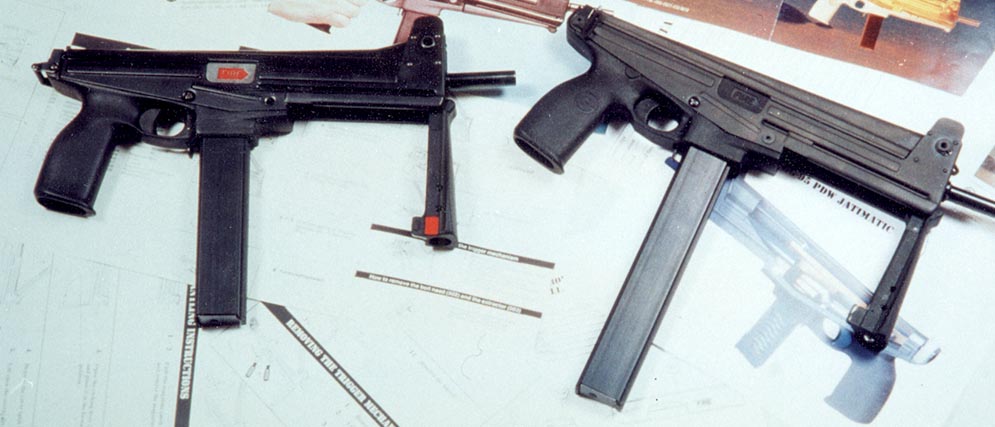By Janne Pohjoispaa, Photos by Juha Rintala
In a different time, in a different place, he would probably have been another Browning, Stoner or Kalashnikov, but the Finnish political climate in the 1970’s and the 1980’s wasn’t favorable for Jali Timari’s designs or any other private ventures of the small arms industry. Development of Timari’s most successful brainchild, the Jati-Matic submachine gun, started in the 1970’s, and it was introduced in 1980. Personal Defense Weapons (PDW) were not the focus of procurement personnel yet, but it was a time when design trends began to favor creation of compact and lightweight submachine guns.
It all started with a low recoil .22 Short caliber Olympic rapid-fire pistol, which Timari was developing in the mid-1970’s. While Timari was doing test firing with his the.22 Short caliber prototype, an untempered trigger sear suddenly broke, and the pistol switched to full auto. The fully automatic .22 Short pistol shot tight patterns due to its lack of muzzle rise. Exceptional low recoil was achieved by means of a principle borrowed from 19th century coastal artillery pieces (like the 1870’s Armstrong cannon). The pistol had an upward slanting bolt path, guiding the bolt upward to turn a part of the recoil force against the muzzle climb. Jali Timari patented the small arms application of this principle. It led to the creation of two pistols, a blowback operating JAT-22 and recoil operated JAT-9, and most important of all, the Jati-Matic submachine gun.
Since the mid-1970’s, Jali Timari has been a designer and co-owner of Tampereen Asepaja (TAP), a small sporting arms manufacturer located in Tampere, a birthplace of the Finnish machine industry. The origin of TAP traces back to 1923, when Niilo Lahtinen founded it. In the post-WWII period TAP’s main products were sporterized military rifles, but in the 1960’s and 1970’s they switched to manufacturing rifles mainly designed by Jali Timari and Torsti Laaksonen. Their main product was an excellent Lakelander bolt action hunting rifle. Other notable designs were the Caribou pump-action rifle and the Finnbiathlon straight-pull action .22 rimfire target rifle designed for biathlon competitions.
In the late 1970’s and early 1980’s TAP attempted to enter the military small arms business. Timari designed a series of military small arms: 9 mm JAT-9 pistol, 9 mm Jati-Matic submachine gun, 5.56 mm assault rifle, 7.62 mm bolt action sniping rifle and a plastic body hand-grenade, called the “Wildcat”. The Jati-Matic submachine gun and the Wildcat hand-grenade were produced in limited quantities in the 1980’s, and the TAP sniping rifle in caliber 7.62 x 54 R participated in the FDF sniping rifle trials, but was not selected. The 9-mm pistol and 5.56 mm assault rifle never proceeded beyond the drawing board or prototype stage.
Tampereen Asepaja manufactured about 400 Jati-Matics, and around 20 Jati-Matics were manufactured by Gunsmith Esa Tiittanen. The Jati-Matic received a lot of publicity through the world; it was evaluated in numerous American publications including Soldier of Fortune and the Gun Digest Book of Assault Weapons. The strict Finnish export regulations for military small arms guarantied that it found no commercial success. In the late 1980’s Tampereen Asepaja went out of business and production of the Jati-Matic ceased for several years.

In 1994 Jali Timari sold all rights and production tooling to a new company, Golden Gun, Ltd. formed by Reijo Parviainen and Kari Kurki. In 1995 Golden Gun, Ltd. (Humalistonkatu 9, FIN-20100 Turku, Finland, Phone +358 2 233 0120, fax +358 2 233 0610) began production of an improved model of the Jati-Matic. Re-named as the GG-95 PDW, the new model has the external appearance and basic construction similar to the original TAP-made Jati-Matic, but included several improvements to the original design.
The current political climate is slightly different, and Golden Gun is now marketing the improved version of the Jati-Matic to military and law enforcement purchasers. The GG-95’s were also sold to private collectors in Finland.
SUBMACHINE GUN OR MACHINE PISTOL?
While two hands are required to operate the Jati-Matic, it lacks a shoulder stock, and therefore falls into the machine pistol category. The general design of the Jati-Matic family is very simple. The total number of parts in the GG-95 is 50. Since 1980 the Jati-Matics were manufactured only in caliber 9 x 19 Luger, but caliber conversions, such as the .40 S & W caliber will require only minor modifications to the bolt, a new barrel and new magazine. However, the .40 S & W version or conversion parts do not presently exist.
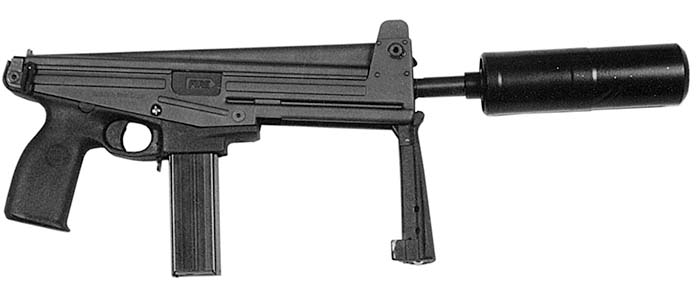
Operating principle of the original Jati-Matic and the GG-95 is the common unlocked blowback. The gun fires from an open bolt with a fixed firing pin. According to Timari’s patented idea first employed in his .22 Short caliber target pistol, it has the bolt guided upwards at a 5 degree angle to produce a vertical resultant force to work against the muzzle rise. Due to the wrap-around bolt design adapted from the Czech vz23/24/25/26 series, UZI, Beretta M 12 etc, a majority of bolt mass lies at the front of the gun’s center of gravity. The barrel line is low and close to the shooter’s hand to minimize the torque of recoil force. The general configuration of the gun will also help to reduce the muzzle climb. The breechblock construction together with the long bolt travel (4.4 inches or 112 mm) reduces the rate of fire to a practical level of 600 – 650 rpm, depending on the ammunition used.
The bolt is machined from an investment cast blank and weighs 0.6 kg (1.42 lbs). It is of two piece construction, consisting of the bolt body and a separate bolt face insert including a fixed firing pin. The bolt body and face are held together by an extractor stamped from spring steel. Bolt face and body can be easily separated for cleaning or replacing damaged parts. The word ‘FIRE’ on the bolt’s left side will appear in the ejection port while gun is cocked. This is a necessary feature, since there is no other cocking indicator and the bolt seals the ejection port in all positions except while ejecting. The bolt has a single recoil spring. The recoil spring’s guide rod rests against the rear buffer, made from elastic, rubber-type material and placed on the joint of the upper and lower receivers.
The GG-95 upper receiver is stamped from a single sheet of 1.2-mm steel plate, while the first Jati-Matics had upper receivers assembled from two pieces by means of spot-welding. The GG-95 upper receiver has no other openings, so it is well sealed against dirt and moisture. The upper receiver has a rectangular cross-section with reinforcing ribs, which will also accumulate dirt and powder residues. The receiver top cover is hinged from its front end to the receiver by a cross pin. The sloping outline of the original Jati-Matic’s top cover led to sighting problems- many operators had a tendency to shoot over the target. The new model is fitted with a receiver cover parallel to the barrel axis, making it better suited for instinctive shooting. The newest TAP-made Jatis appeared with this feature. The GG-95 top cover latch is similar to the original Jati-Matic design, but without an integrated rear sling swivel. The old pattern swivel had a built-in possibility of accidentally opening the top cover. Pulling the sling in the wrong direction opened the cover. The GG-95 has detachable sling swivels that can be mounted on either side of gun.
THE LOWER RECEIVER IS MADE FROM PLASTIC
General coloring of the GG-95 is matte black. For some reason the barrel has a bright blue finish, but all other metal surfaces are bead blasted and then blued. The result is a matte surface, resembling the manganese phosphate (Parkerized) finish. The lower receiver and other plastic parts have similar coloring.
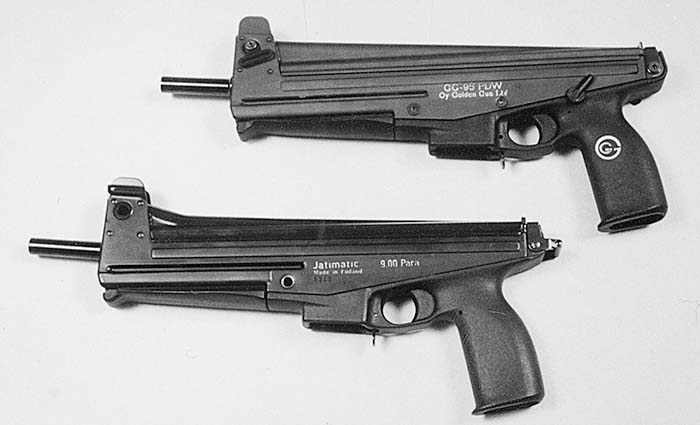
The GG-95’s lower receiver is injection molded from polymer material called Polyphtalamide, shock resistant and insensitive to oils, solvents and powder residues. The foregrip/cocking handle assembly and some components of the trigger mechanism are also molded from the same polymer. Plastic parts were also widely used with the original Jati-Matic. It was not a surprise that many components of his submachine gun were made from polymer materials. Jali Timari, who had worked in the plastic industry since 1946, has a broad knowledge of manufacturing plastic components and the tools for the process.
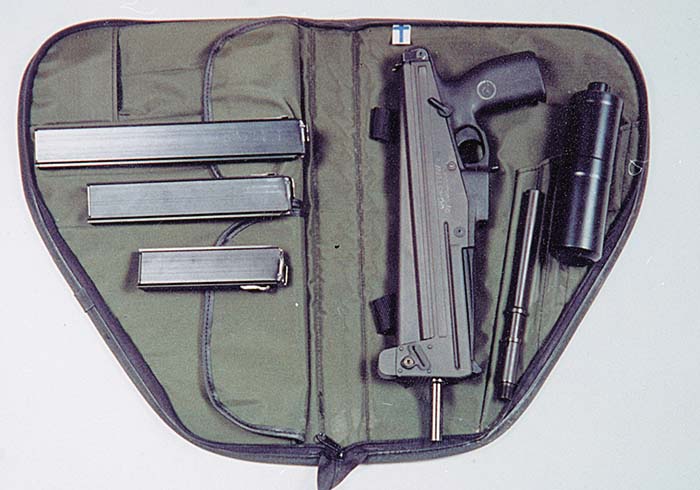
Four screws mate the GG-95 upper and lower receivers. The lower receiver includes the magazine well with the AK-type magazine catch. The lower receiver also houses the trigger mechanism, which is built in a steel-framed module. This trigger module is mounted by means of one cross-bolt, and it can be easily removed for maintenance.
The original Jati-Matic has the fire selector integral to the trigger, similar to the Steyr AUG. A short trigger pull is required for firing single shots and a long pull allows fully automatic fire. Skilled operators can successfully master this type of mechanism, but inexperienced operators will face problems with finding the desired fire mode, especially while working under stress. The GG-95 has a selector switch placed on the left side of the lower receiver with two fire modes, semi-auto and full-auto. Timari designed a trigger mechanism capable of firing single shots, 2 or 3 rd bursts and continuous full auto fire, but the Jati-Matic with this feature never went beyond the prototype stage. Personally, I consider a single shot mode pointless, because the role of this type of firearm will seldom require single shot firing. In any case, there is now a thumb-operated fire selector for all kinds of submachine gunners.
The operation and location of the Jati-Matic and GG-95 safety catch is far from where we are accustomed to using it. The trigger mechanism has no separate safety catch, but the cocking handle/foregrip serves as the safety and locks bolt movement while folded into the carry position. While the foregrip is folded, the gun can safely be carried in Condition One (cocked and locked). A sliding forearm/cocking handle patterned after a typical pump action shotgun forearm was designed after the request of some law enforcement officials. In my opinion, the folding foregrip should be fitted with an integrated, “D”-shaped finger loop, which would speed up bringing the gun into action. The GG-95 has no shoulder stock, but handling and firing characters would improve a great deal if a well engineered folding stock was added on this system. Although Jali Timari didn’t favor the shoulder stock, there was a top folding stock for the original Jati-Matic, made in very limited quantities. The shoulder stock for the current GG-95 could be of the side folding type, which could be removed if desired.
The GG-95 has an 8-inch (203-mm) barrel. The bore has six grooves with a right hand twist of one turn in 9.84 inches (250 mm). The barrel rests over the upper receiver. It contacts the receiver at two points, one at the rear end and the other near the muzzle end. The barrel is held in the correct place and position by two circular rims turned on the barrel, and an indexing stud at the front end of the receiver. The barrel is clamped securely while the top cover is folded down. The barrel has no feed ramp; cartridges are fed into the chamber straight from the magazine. The standard barrel has a plain muzzle without any mounting device for a sound suppressor. After the manner of the original Jati-Matic, a separate suppressor barrel with a threaded muzzle is available for the GG-95. This threaded barrel has a left-handed metric M14 x 1 thread to accept all Kalashnikov-compatible sound suppressors. The left-handed thread prevents suppressor loosening caused by interaction of barrel twisting and the suppressor’s inertia. In the 1980’s, the Jati-Matics were usually equipped with the famous Vaime suppressors, while in the 1990’s the GG-95s are fitted with Finnish BR’s KRS (Kalashnikov Reflex Suppressor) muzzle cans.
The Jati-Matic and GG-95 magazines are of double column type and available optionally with 20 rd, 30 rd and 40 rd capacity. The magazine is very similar to the Carl Gustav 36 round stick magazine but unfortunately not interchangeable with them. The GG-95 won’t accept Carl Gustav, Smith & Wesson etc. magazines or vice versa. The magazine body is made from extruded aluminum alloy and the follower is injection molded from plastic. The similar sized 40 rd magazine is remarkably lighter than the all-steel Carl Gustav/Suomi 36 rd stick, and it is as reliable and easy to fill as original Swedish (for the Carl Gustav M/45) and Finnish (for the Suomi M/31) magazines. No loading tool is required for filling the Jati-Matic family of magazines.
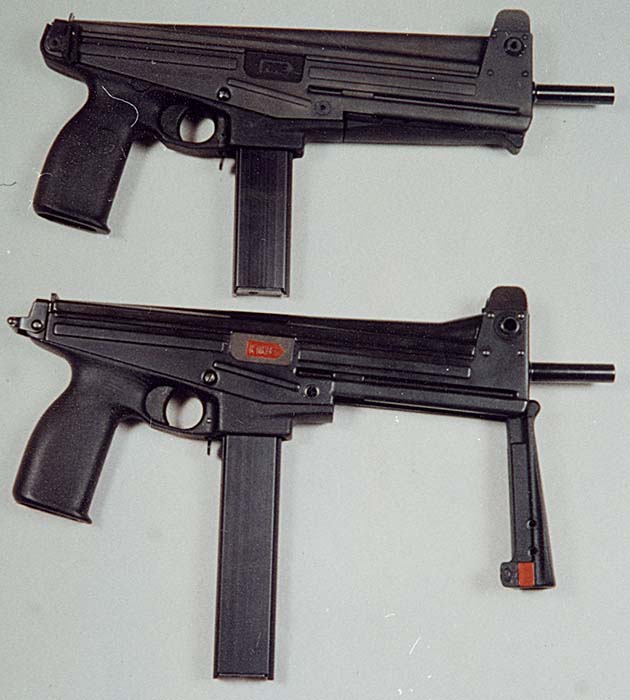
Sights are rather crude, but it doesn’t matter because this gun won’t be used for target competitions. Both the original Jati-Matic and the GG-95 have a vertically adjustable foresight and a fixed open notch type rear sight. The GG-95 rear sight is integrated on the top cover latch, while the original Jati-Matic has the rear sight integrated on the lower receiver. The Jati-Matic family will also accept additional sighting devices, which this author considers to be of questionable value. In the early 1980’s, large first generation laser sighting devices of D-cell Maglite size were occasionally fitted on the original Jati-Matics. Currently Golden Gun, Ltd. offers a separate top cover to mount tactical lights and auxiliary sighting devices.
HANDLING AND FIRING
The Jati-Matic and GG-95 are “two hand” weapons without a shoulder stock. They fit in the same category as the H & K MP5K, Famae Mini-SAF and Steyr TMP. The Jati-Matic is apparently less expensive than any of its competitors.
The most significant feature of the Jati-Matic family is exceptional controllability. Even operators without experience with a small sized full-auto firearm can fire long (10 shots or more) bursts and keep every bullet hole in a 12 inch (0.3 m) diameter target at distances up to 15 meters. An experienced operator will achieve far better patterns. Adding an extra weight on the muzzle e.g. in form of a sound suppressor will help to control recoil. In addition the sound suppressor will reduce the risk for hearing damage if the firearm is discharged indoors, as many CQB scenarios will usually require.
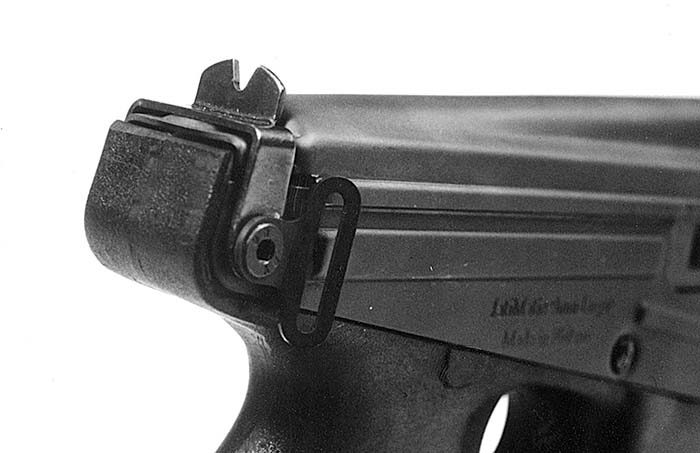
Old TAP brochures used the slogan “Full-Auto Fire With One Hand”. Firing long bursts with any member of the Jati-Matic family with a “one hand” hold will cause poor controllability. The same goes for using a Weaver stance “Two hand” hold. There is a foregrip, so always use it while firing bursts. Some operators fire the Jati’s frequently from underarm and use bullet strikes on target to correct fire. Generally speaking, this is just spraying bullets around, and in conflict with the professional principle that the first shot should count. This is an especially unsuitable method to use in crowded places. Personally I prefer firing aimed bursts holding the gun at eye level with both hands.
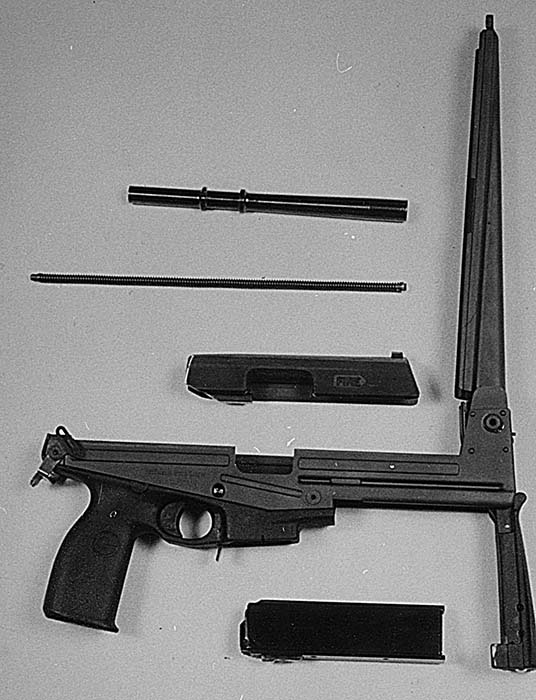
While the gun is carried in cocked & locked position, it is brought into action quickly by turning the foregrip to the downward position. Golden Gun, LTD supplies both belt and shoulder holsters, which are patterned after handgun holsters. Larger and heavier submachine guns will require somewhat different rigs. For carrying the original Jati-Matic or the GG-95, I prefer to use a shoulder rig, e.g. similar to the one developed by Eagle Industries for the MP5K.
In our test firing, two types of 9-mm ammunition were used. We had Finnish Lapua-made 9 mm ball fitted with a 115 gr. (7.5 g) FMJ bullet loaded to nominal muzzle velocity of 1330 fps (405 mps) close to NATO specifications, and Lapua 9 mm subsonic round fitted with a 150 gr. (9.7 g) CEPP (Controlled Expansion Police Projectile) bullet. During the course of test firing, about 400 shots were fired. No malfunctions were observed.
Recently there has been a lot of discussion about successors to the 9-mm Luger. While it would be interesting to test fire a 5.7 x 28 mm caliber version of the Jati-Matic, it seems that the 9 mm Luger caliber handguns and SMG’s will remain as the world standard in the foreseeable future. Advanced ammunition technology and millions of guns around the world chambered for that cartridge make this likely. The 9 mm Luger, a workhorse of many wars and different ideologies, is still going strong and even more popular than ever before.
One feature in the Jati-Matic and the GG-95 bothers me little: there are accessory components required for mounting other accessories. Personally I think that the basic implements like a sound suppressor or a tactical light should be mounted on any firearm of this type with a minimum effort.
In this form or rather with some diminutive modifications including the re-engineered cocking handle and shoulder stock, the attractively priced GG-95 will be a potent competitor for other subguns or machine pistols of similar size.
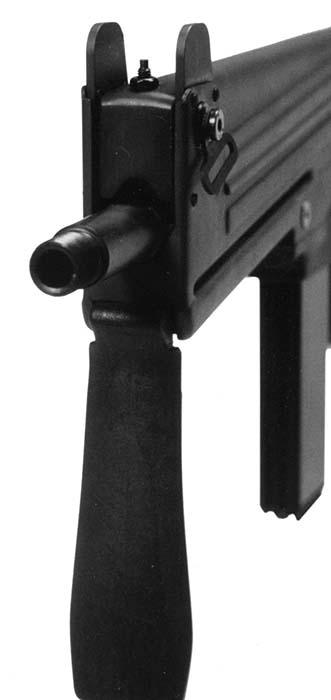
The GG-95 submachine gun specifications
- Caliber: 9 x 19 mm Parabellum
- Operation: Blowback, fires from an open bolt. Selective fire trigger mechanism fires both single shots and burst fire.
- Feed mechanism: Detachable staggered-row box magazine for 20, 30 or 40 rounds
- Barrel: Six grooves with a right hand twist of one turn for 9.84 inches (250 mm).
- Lengths: Overall: 14.8” (375 mm) Barrel: 8” (203 mm)
- Weights: (empty) 3.63 lbs (1.65 kg)
- Sights: Protected post front, adjustable for windage. Fixed rear.
- Finish: Blued
- Manufacturer: Golden Gun, Ltd, Humalistonkatu 9, FIN-20100 Turku, Finland. Phone +358 2 233 0120. Fax +358 2 233 0610.
| This article first appeared in Small Arms Review V1N6 (March 1998) |



